Dell XPS L501x: An Excellent Mainstream Notebook
by Jarred Walton on November 10, 2010 12:01 AM ESTA Good High Gamut, High Resolution LCD
Wrapping up the test results, we have the B+GR LED (i.e. WLED) backlit 1080p display. We can't comment on the standard 768p panel, but considering all the results we've seen on such panels to date it's hard to imagine Dell is going to have anything more than a mediocre, low-contrast offering. What they give users is the ability to upgrade to a substantially better 1080p display, and while it doesn't top the WUXGA RGB LED panel in the Dell Precision M6500, it also doesn't bump the price up $300. Actually, short of A/B side-by-side comparisons, we think most users will be very pleased with the 1080p upgrade. It took me all of five seconds after the initial power on to notice that the panel had a good contrast ratio, and colors in images look far better in my opinion than what you get with typical laptop LCDs.
Having used the Dell Studio XPS 16 for a while, I actually prefer the new panel design, but that's mostly because of the silliness of the old "Edge-to-Edge" display. The Studio XPS 16 had a glossy sheet of plastic that was placed over the LCD panel, and when closed the "LCD" rested against the keyboard and palm rest. The result is that the plastic sheet would accumulate smudges and other marks just through normal use over time (though I've heard if you could manage to remove the glossy sheet that the underlying panel was actually a matte display). In contrast, the LCD in the L501x is a traditional affair recessed into the cover slightly, so the only way it will get smudges is if you—or your friends/kids/spouse—touch it. So, the design is better but the panel itself might not be quite as good—more on this after the charts.
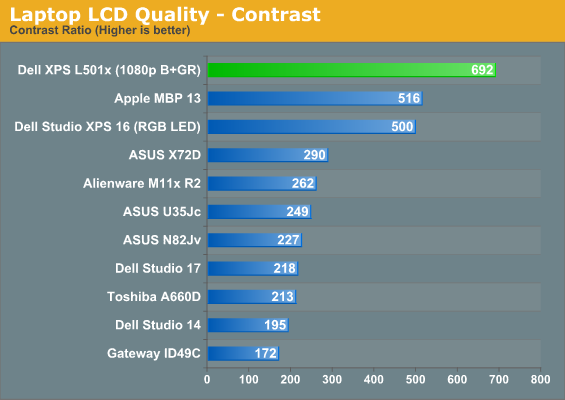
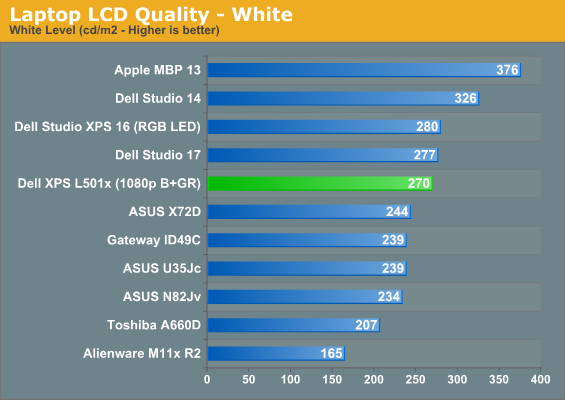
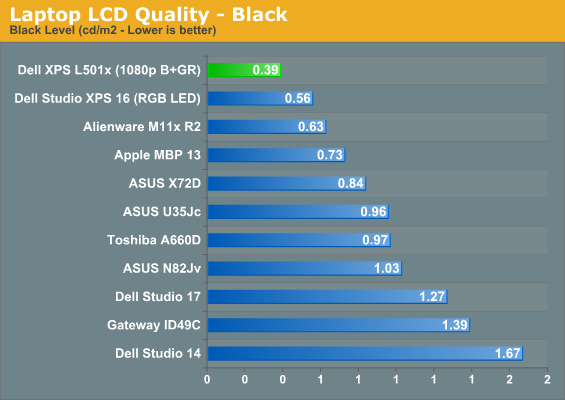
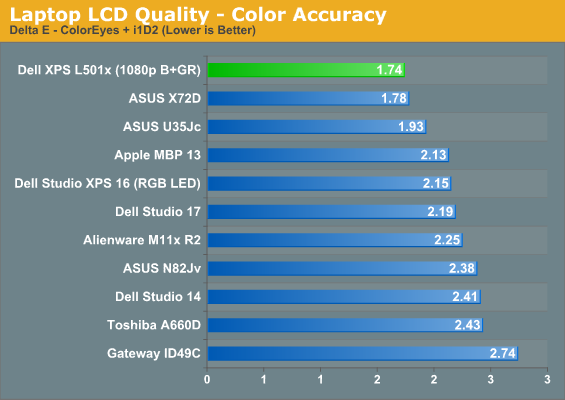
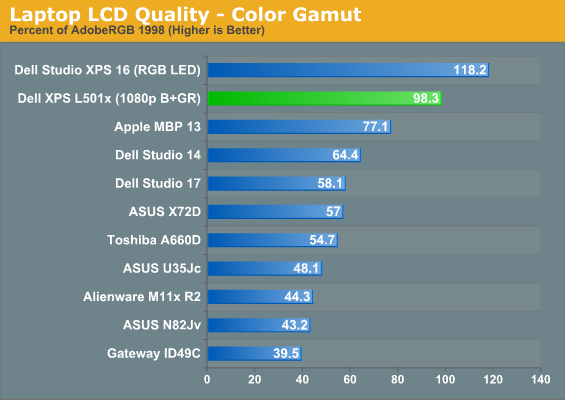
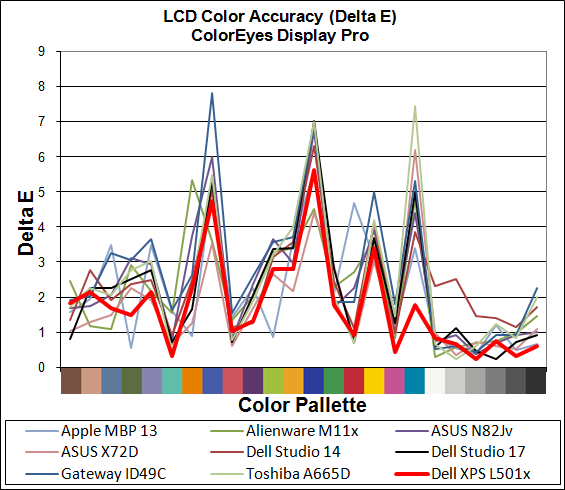
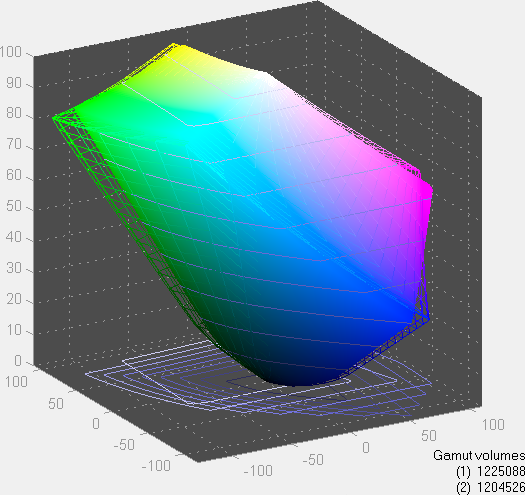
The objective results bear out my initial impression: the contrast ratio comes in nearly 700:1, which tops our charts and outranks even the current MacBook Pro LCDs—including the matte MacBook Pro 15 WSXGA+ panel. But then, glossy displays are usually higher contrast so that last point isn't an entirely fair comparison. Regardless, the display looks great, and it has a good maximum white level of 270nits as well. Maximum brightness is still an area that favors MacBooks, but then color quality favors the L501x.
It's worth noting that there are times when a higher color gamut isn't "best"—specifically, the default Windows color space is sRGB, which is around 82% of ARGB1998. That means if you run an application that isn't color space aware (i.e. most applications!), you'll map to sRGB and your 100% of ARGB1998 gamut now makes colors look saturated. That's not to say it's bad, but there are times (particularly if you're watching videos) where the oversaturated colors are apparent. Then again, would you rather have an image that's a bit oversaturated, or do you like images that are highly undersaturated? Because the latter is what you get with virtually every other laptop panel.
We did some side-by-side comparisons with the L501x and three other laptops to show what it looks like when viewing the standard 24-color GretagMacbeth ColorChecker palette (the same palette we use for our Delta E testing)—you can also see the viewing angles in the above gallery. The first comparison is with a typical ~50% gamut low-contrast LCD; in this particular instance we're looking at the Acer 5551G. Next up is the high-contrast 1080p panel in the ASUS G73Jw, with a 55% gamut. The third comparison is with the older 120% gamut Studio XPS 16 with the RGB LED panel. You can definitely see that the high gamut panels look more vibrant (too much so some would say), and in this case the 98% gamut on the new panel is an improvement. In an ideal world, you'd be able to choose between 82% sRGB backlighting and 100% ARGB1998 backlighting at the flip of a switch, but for now you'll have to settle for one or the other. Apple's MacBook Pro comes closer to the sRGB setting most people use and as such would be slightly preferable, but in practice it will usually only matter if you're really a stickler for accurate colors in certain applications.
For the record, the above ColorChecker chart looks "correct" when viewed in Firefox or the standard Windows Picture Viewer (though not in fullscreen mode for the latter). Opening the image in Internet Explorer (or viewing fullscreen in Picture Viewer) gives the oversaturated look seen in the above photographs. Videos also bypass any color profile you may have loaded, resulting in overly vibrant colors at times. Personally, I didn't have a problem with the way the colors look, especially if I don't have something else nearby to compare it with; your eyes will adjust to whatever you see.
Heat and Noise Levels
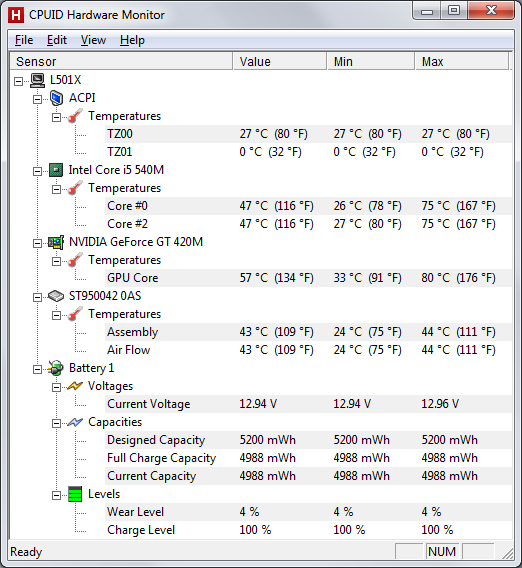
After taxing the system for more than an hour with 3DMark06, system component temperatures remained acceptable. Surface temperatures of the L501x were also satisfactory; the L501x isn't a cool running CULV laptop by any stretch of the imagination, but it doesn't become unbearably warm either. At idle or under light loads, surface temperatures ranged from 27-35C on the bottom, and 27-32C on the palm rests and keyboard, with a noise level nearing the limits of our testing equipment at just 31dB (in a sub-30dB environment). The 3DMark06 loop brought surface temperatures up to 27-40C on the bottom and 27-34C on the keyboard area, with the exhaust vent at 40C. The hottest spot is under the middle-left area, where the GPU sits. Maximum noise levels were consistent under load, with a moderately loud but not horribly annoying rating of 42dB.
















95 Comments
View All Comments
Goblerone - Wednesday, November 10, 2010 - link
Still waiting for clarification for why the GTX 580 review compared against reference clocked competitor cards whereas the Radeon 6870 review compared against factory overclocked cards.Cool thanks!
The_Assimilator - Wednesday, November 10, 2010 - link
Maybe because there weren't any overclocked GTX 580s available at launch? And please, stop with the whining about the comparisons.JarredWalton - Wednesday, November 10, 2010 - link
Because everyone complained about the use of an overclocked card so Ryan and Anand chose to not use any overclocked cards in future comparisons. I thought that was pretty clear, in light of all the complaining that occurred, and the overclocked results for 6850 are available. Besides, GTX 580 is going up against 6900 next month or whenever, and that will be the real comparison.As I see it, imagine NVIDIA came out with GTX 560 right now, instead of AMD with the 6800. Imagine AMD's partners had a ton of highly overclocked 5870 parts and we put one in as a reference point for what the competition could do. Then we concluded that the GTX 560 was still a good card and worth purchasing, based on power and performance and price, but that the overclocked 5870 was highly competitive. That's basically what happened in reverse, and I'm still surprised at how upset people got.
But this is neither the time nor the place for that discussion so I'd appreciate it if we could avoid bringing up separate articles that have nothing to do with this review.
Or if you want another example, imagine I reviewed an ASUS laptop, and in the conclusion I put the whole package into the grand scheme of the market. What if I then said that while the performance was good, other factors were so neglected that need work. Or what if I discussed something like a MacBook, Envy, etc. in a review of a Dell laptop? The horror!
Personally, I view my job as a journalist/hardware reviewer to be one of coming up with the best recommendations, regardless of manufacturer. If HP suddenly priced the Envy 14 at $850 just to compete with the L501x, but it was a limited time offer, I'd still happily mention the option in my review. Giving more detail and points of reference has never been a bad thing to me (unless it gets to the point where my graphs become unwieldy of course). That's my two cents, for what it's worth.
Evil_Sheep - Wednesday, November 10, 2010 - link
Actually the Envy 14 was dropped to $850 about a week ago in a limited time deal (already expired), only available through Logicbuy. It was actually a $400 off coupon on any config over $1250, which meant some decent specs as well.I wouldn't be surprised to see more offers like this from HP in the future to keep them competitive, especially after disappointments like the loss of the Radiance panel and, on the Beats edition, the removal of the included headphones.
khimera2000 - Wednesday, November 10, 2010 - link
Isint this already covered??? its like beeting a dead horse for a week strait. they goofed, and now there doing there best to make up for it. thats all i need.erple2 - Friday, November 12, 2010 - link
I'm also waiting for clarification about the global economic recovery plan put forth by the G20 Summit meeting in S. Korea!a1trips - Wednesday, November 10, 2010 - link
I didn't weigh into the debate earlier but i would tend to support your position that all information must be given the reader on the assumption that they are mature adults who can make up their own minds.I still don't see what the hullabaloo was about regarding the overclocked card and i thought those who didn't care were in the majority, but that's just my take.
~atr
Osamede - Wednesday, November 10, 2010 - link
Let's face it Dell still doesnt get it. Shipping a 15" unit with a 6 cell battery that isnt going to last all that long is no good. And the "option" of a 9-cell that sticks out like a sore thumb is just outdated.I'm no Apple fan but at least they understand that a quality laptop is one that doesnt leave you worrying about your battery AND doesnt have huge lumps sticking out of it.
In any case this 15" brick unit is a sideshow and is no change really, as Dell has always had 15" units with a decent screen that were ugly like this one.
The real point where we will know that PC makers are actually interested in upping their game is when they start producing lightweight laptops at 13" or 14" that have top notch screens. At that point we can discuss. But really only Sony is making a play there. The rest are jokers, Dell included.
strikeback03 - Wednesday, November 10, 2010 - link
There are plenty of users for whom 3-4 hours of battery life is plenty, as they use the system mostly as a DTR and not on the go. No point in making the system large enough to hold the 9 cell battery when a large number of users don't need that capacity.Better battery life by default in Windows would be nice, but if it is a choice between having all the varied hardware available and better battery life tweaks I would definitely take the hardware choices. I also don't consider Apple's integrated battery to be at all an option.
pieterjan - Wednesday, November 10, 2010 - link
This thing must be the ugliest notebook Dell ever pooped out. Okay, it has some aluminum panels, but so do street poles.